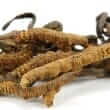Background
- Cordyceps sinensis, the Cordyceps species most widely used as a dietary supplement, naturally grows on the back of the larvae of a caterpillar from the moth Hepialus armoricanus Oberthur found mainly in China, Nepal, and Tibet. The mycelium invades the caterpillar and eventually replaces the host tissue. The stroma (fungal fruit body) grows out of the top of the caterpillar. The remaining structures of the caterpillar along with the fungus are dried and sold as the dietary supplement cordyceps.
- Commonly known as "dong chong xia cao" (summer-plant, winter-worm) in Chinese, cordyceps has been used as a tonic food in China and Tibet and has been used as a food supplement and tonic beverage among the rich because of its short supply due to over harvesting. It is also an ingredient in soups and other foods used traditionally in Chinese medicine for thousands of years helping debilitated patients recover from illness.
- Cordyceps is used therapeutically for asthma, bronchitis, chemoprotection, exercise performance, hepatitis B, hepatic cirrhosis, hyperlipidemia (high cholesterol), as an immunosuppressive agent, and in chronic renal failure.
- The fungus became popular in 1993 when two female Chinese athletes, who admitted using cordyceps supplements, beat the world records in the track and field competition at the Stuttgart World Championships for the 1,500-, 3,000-, and 10,000-meter runs. The women were drug tested for any banned substances such as steroids and were negative. Their coach attributed the performance to the cordyceps supplementation.
References
Natural Standard developed the above evidence-based information based on a thorough systematic review of the available scientific articles. For comprehensive information about alternative and complementary therapies on the professional level, go to . Selected references are listed below.
- Chen J, Zhang W, Lu T, et al. Morphological and genetic characterization of a cultivated Cordyceps sinensis fungus and its polysaccharide component possessing antioxidant property in H22 tumor-bearing mice. Life Sci 5-1-2006;78(23):2742-2748.
View Abstract - Kim HG, Shrestha B, Lim SY, et al. Cordycepin inhibits lipopolysaccharide-induced inflammation by the suppression of NF-kappaB through Akt and p38 inhibition in RAW 264.7 macrophage cells. Eur J Pharmacol 9-18-2006;545(2-3):192-199.
View Abstract - Kunwar RM, Nepal BK, Kshhetri HB, et al. Ethnomedicine in Himalaya: a case study from Dolpa, Humla, Jumla and Mustang districts of Nepal. J Ethnobiol Ethnomedicine 2006;2:27.
View Abstract - Lee H, Kim YJ, Kim HW, et al. Induction of apoptosis by Cordyceps militaris through activation of caspase-3 in leukemia HL-60 cells. Biol Pharm Bull. 2006;29(4):670-674.
View Abstract - Li FH, Liu P, Xiong WG, Xu GF. [Effects of Cordyceps sinensis on dimethylnitrosamine-induced liver fibrosis in rats]. Zhong Xi Yi Jie He Xue Bao 2006;4(5):514-517.
View Abstract - Li SP, Yang FQ, Tsim KW. Quality control of Cordyceps sinensis, a valued traditional Chinese medicine. J Pharm Biomed Anal 8-28-2006;41(5):1571-1584.
View Abstract - Li SP, Zhang GH, Zeng Q, et al. Hypoglycemic activity of polysaccharide, with antioxidation, isolated from cultured Cordyceps mycelia. Phytomedicine 2006;13(6):428-433.
View Abstract - Liu WC, Wang SC, Tsai ML, et al. Protection against radiation-induced bone marrow and intestinal injuries by Cordyceps sinensis, a Chinese herbal medicine. Radiat Res 2006;166(6):900-907.
View Abstract - Rukachaisirikul V, Chantaruk S, Tansakul C, et al. A cyclopeptide from the Insect pathogenic fungus Cordyceps sp. BCC 1788. J Nat Prod 2006;69(2):305-307.
View Abstract - Wang NQ, Jiang LD, Zhang XM, et al. [Effect of dongchong xiacao capsule on airway inflammation of asthmatic patients]. Zhongguo Zhong Yao Za Zhi 2007;32(15):1566-1568.
View Abstract - Wu WC, Hsiao JR, Lian YY, et al. The apoptotic effect of cordycepin on human OEC-M1 oral cancer cell line. Cancer Chemother Pharmacol 10-10-2006.
View Abstract - Wu WC, Hsiao JR, Lian YY, et al. The apoptotic effect of cordycepin on human OEC-M1 oral cancer cell line. Cancer Chemother Pharmacol 2007;60(1):103-111.
View Abstract - Yoo O, Lee DH. Inhibition of sodium glucose cotransporter-I expressed in Xenopus laevis oocytes by 4-acetoxyscirpendiol from Cordyceps takaomantana (anamorph = Paecilomyces tenuipes). Med Mycol 2006;44(1):79-85.
View Abstract - Yu HM, Wang BS, Huang SC, Duh PD. Comparison of protective effects between cultured Cordyceps militaris and natural Cordyceps sinensis against oxidative damage. J Agric Food Chem 4-19-2006;54(8):3132-3138.
View Abstract - Zhang G, Huang Y, Bian Y, et al. Hypoglycemic activity of the fungi Cordyceps militaris, Cordyceps sinensis, Tricholoma mongolicum, and Omphalia lapidescens in streptozotocin-induced diabetic rats. Appl Microbiol Biotechnol 2006;72(6):1152-1156.
View Abstract







